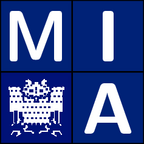
Welcome to the homepage of the lecture
Numerical Algorithms for Visual Computing I
Summer Term 2010
Home
About Us
People
Teaching
Research
Publications
Awards
Links
Contact
Internal
Numerical Algorithms for Visual Computing I
PD Dr. Michael Breuß
Summer 2010
Lectures (3h) with exercises (1h), summer term 2010, 6 credits
Lectures:
Thursday 10–12 (10 a.m.–12 p.m.),
and Friday 14–16 (14 p.m.–16 p.m.),
Building E13, Lecture hall 003
The tutorials take place by appointment instead of a lecture (i.e. same time and place).
The results of the SECOND written examination are now available
here!
SECOND WRITTEN EXAM The second written exam will take place thursday, the 23rd of September, 10-12 a.m., Lecture hall 003, Buidling E1.3.
This is a course in numerical methods useful in the field of visual computing. Covered are interpolation, approximation, splines, least-squares-computation, the fast Fourier transform (FFT) and other issues.
Entrance requirements – Contents – Assessments / Exams – References
Undergraduate knowledge of mathematics. For computer science students, this requirement is met by having completed the Mathematics for Computer Scientists lecture cycle.
Mathematical prerequisites which exceed the basic mathematics courses are provided within the lecture. Previous knowledge is not required.
The course is concerned with numerical methods useful for image analysis (image processing, computer vision, pattern recognition) and synthesis (computer graphics, scientific visualisation, geometric modelling).
Topics include:
- interpolation (splines)
- approximation (least squares, total least squares, pseudoinverse)
- Fast Fourier transform
There will be two written exams. The first will be close to
the end of the semester. The second one will be in the lecturing-free period.
It is required for qualifying for the written exams to have 50% of the available points from the exercises. I would like to encourage you to do these in teams of up to three students.
Very likely, I will offer the opportunity to do a small project around the middle of the semester to gain extra points.
Additional Information. The content covered in the first written exam is concerned with the material of the current state of the revised script, and by the Assignments 1 to 5. The last parts will be covered in the second written exam. Concerning the allowed material, you may bring along the course material from the lectures and tutorials, including example solutions. No pocket calculator is allowed.
Details on this will be given in the script. This will be made available via this webpage.
Participants of the course can download the assignment sheets here:
| No. | Title | Deadline | Example Solution | SciLab-file |
The example solutions are based on the TeX-files of Tanja Dorst, Verena Marold and Michael Stoll. Many thanks to them for providing the files!
MIA Group
©2001-2023
The author is not
responsible for
the content of
external pages.
Imprint -
Data protection